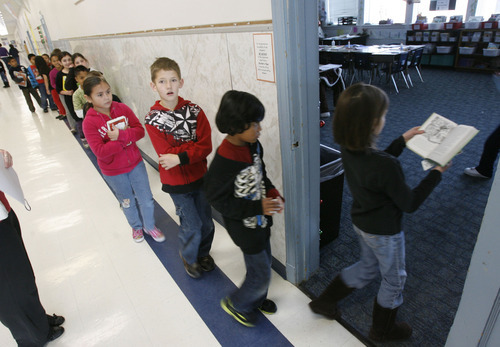This is an archived article that was published on sltrib.com in 2012, and information in the article may be outdated. It is provided only for personal research purposes and may not be reprinted.
Utah has long had some of the largest class sizes in the nation, but at least one lawmaker hopes to change that this coming legislative session.
Sen. Karen Morgan, D-Cottonwood Heights, plans to run a bill to lower class sizes in kindergarten through third grade. The bill, SB31, would limit the number of students in academic classes to 18 in kindergarten, 20 in first grade, 22 in second grade and 24 in third grade. Or, it would require teachers' aides, known as paraprofessionals, in larger classes.
"We just need to get serious about lowering class sizes in K-3 so those children can get those basic foundational skills they need," said Morgan, who is also Senate minority whip. "In order for a teacher to be able to give that focused instruction, they need to have fewer children in the classroom."
Now, the state's median class sizes are 22 for kindergarten, 23 for first grade, 24 for second grade and 25 for third grade, according to the State Office of Education. Utah had the highest student-to-teacher ratio in the nation — 27 students per teacher — in 2008-09, according to the National Center for Education Statistics.
"I think anything we can do to reduce class sizes in Utah is a step in the right direction," said Sharon Gallagher-Fishbaugh, Utah Education Association president, noting that gaps exist between the skills of many young children. "It's absolutely essential you have enough manpower, enough hands on deck, to address those needs."
Not everyone, however, is as excited about the idea, which has been met with resistance in past years. Morgan tried to pass other bills aimed at reducing class sizes in 2007 and 2008 without success. In both cases, the bills made it out of the House but stalled in the Senate.
Judi Clark, executive director of Parents for Choice in Education, said class size reduction doesn't necessarily improve achievement unless it's lowered more dramatically.
A landmark study conducted in Tennessee in the 1980s found that K-3 classes of 13 to 17 students outperformed classes of 22 to 26 students. Also, a Utah State Office of Education analysis recently found that schools that failed to meet federal testing goals had larger class sizes on average than those that passed.
Still, other research hasn't been definitive.
"There's a lot of things that we can do to help our students improve, especially in those critical grades of K-3, but we can't just get caught up in a talking point of smaller class sizes and cross our fingers and hope it works," Clark said. "Parents for Choice is leery of simple solutions of smaller class sizes when there are so many more dynamic innovations out there that better prepare students."
Sen. Howard Stephenson, R-Draper, said he'd like to see standards set for the money school districts already receive to lower class sizes and see that existing money used more effectively.
A 2007 legislative audit showed that $460 million meant to make class sizes smaller in Utah over seven years hadn't led to any change, though some have said class sizes would have been even larger if not for that money.
In recent years, class sizes have increased slightly as school districts grappled with budget cuts.
"If we give money in the name of class size reduction it ought to show some sort of result," Stephenson said. He said, however, if Morgan wants more money for class size reduction, as opposed to just a continuation of what's been given, "I would certainly consider it, but it would need to be weighed along with all other requests, given limited resources."
Morgan said she'd like to see more money put toward class-size reduction but said it will be up to the legislative fiscal analyst to determine how much, if any, additional money should be attached to her bill. It could be an expensive proposition. It cost the Davis School District about $2.5 million just to reduce average class sizes by one student in kindergarten through third grade this school year.
But Morgan said she believes now is a good time for the proposal to become reality.
"It is looking like there is more money coming into our education fund, so I believe this should be one of our highest priorities," Morgan said, noting that her bill would phase in the changes starting with kindergarten next school year and adding one grade each year for the next three years, meaning the cost would be spread over time.
She said she believes reducing class sizes would make a difference.
"They can take statistics and use them to say whatever they want to say," Morgan said, "but when I talk to teachers and when I talk to parents I think it does make a difference, especially if you're going from 32 or 35 down to 18."
Sen. Aaron Osmond, R-South Jordan, who is the new chairman of the Senate Education Committee, said he supports the idea of reducing class sizes but as one of many elements to bolster early childhood education.
He said given the state's limited resources, "what we have to do is choose where we're going to get the most bang for our buck, and I believe investing in early education, such as reducing class sizes in K-3 and other elements, will be a very positive way to use our resources."
Twitter: @lschencker





